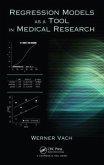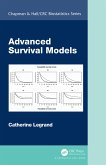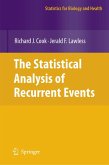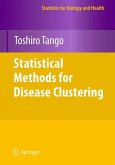- Gebundenes Buch
- Merkliste
- Auf die Merkliste
- Bewerten Bewerten
- Teilen
- Produkt teilen
- Produkterinnerung
- Produkterinnerung
Surveys the current state of epidemic modelling, resulting from the NATO Advanced Workshop at the Newton Institute.
Andere Kunden interessierten sich auch für
![Linear and Generalized Linear Mixed Models and Their Applications Linear and Generalized Linear Mixed Models and Their Applications]() Jiming JiangLinear and Generalized Linear Mixed Models and Their Applications90,99 €
Jiming JiangLinear and Generalized Linear Mixed Models and Their Applications90,99 €![Linear and Generalized Linear Mixed Models and Their Applications Linear and Generalized Linear Mixed Models and Their Applications]() Jiming JiangLinear and Generalized Linear Mixed Models and Their Applications90,99 €
Jiming JiangLinear and Generalized Linear Mixed Models and Their Applications90,99 €![Regression Models as a Tool in Medical Research Regression Models as a Tool in Medical Research]() Werner VachRegression Models as a Tool in Medical Research137,99 €
Werner VachRegression Models as a Tool in Medical Research137,99 €![Advanced Survival Models Advanced Survival Models]() Catherine LegrandAdvanced Survival Models174,99 €
Catherine LegrandAdvanced Survival Models174,99 €![It's Great! Oops, No It Isn't It's Great! Oops, No It Isn't]() Ronald GauchIt's Great! Oops, No It Isn't75,99 €
Ronald GauchIt's Great! Oops, No It Isn't75,99 €![The Statistical Analysis of Recurrent Events The Statistical Analysis of Recurrent Events]() Richard J. CookThe Statistical Analysis of Recurrent Events119,99 €
Richard J. CookThe Statistical Analysis of Recurrent Events119,99 €![Statistical Methods for Disease Clustering Statistical Methods for Disease Clustering]() Toshiro TangoStatistical Methods for Disease Clustering99,99 €
Toshiro TangoStatistical Methods for Disease Clustering99,99 €-
-
-
Surveys the current state of epidemic modelling, resulting from the NATO Advanced Workshop at the Newton Institute.
Hinweis: Dieser Artikel kann nur an eine deutsche Lieferadresse ausgeliefert werden.
Hinweis: Dieser Artikel kann nur an eine deutsche Lieferadresse ausgeliefert werden.
Produktdetails
- Produktdetails
- Verlag: Cambridge University Press
- Seitenzahl: 444
- Erscheinungstermin: 9. Juni 2003
- Englisch
- Abmessung: 235mm x 157mm x 31mm
- Gewicht: 867g
- ISBN-13: 9780521475365
- ISBN-10: 0521475368
- Artikelnr.: 22303157
- Herstellerkennzeichnung
- Libri GmbH
- Europaallee 1
- 36244 Bad Hersfeld
- gpsr@libri.de
- Verlag: Cambridge University Press
- Seitenzahl: 444
- Erscheinungstermin: 9. Juni 2003
- Englisch
- Abmessung: 235mm x 157mm x 31mm
- Gewicht: 867g
- ISBN-13: 9780521475365
- ISBN-10: 0521475368
- Artikelnr.: 22303157
- Herstellerkennzeichnung
- Libri GmbH
- Europaallee 1
- 36244 Bad Hersfeld
- gpsr@libri.de
Preface; Introduction; Part I. Conceptual Framework: 1. Some problems in
the theory of infectious disease transmission and control Klaus Dietz; 2.
The structure of epidemic models Denis Mollison; 3. Coupling methods in
epidemic theory Frank Ball; 4. Collective epidemic processes: a general
modelling approach to the final outcome of SIR epidemics Claude Lefévre and
Philippe Picard; 5. The threshold concept in deterministic and stochastic
models Ingemar Nasell; 6. How does transmission of infection depend on
population size? Mart de Jong, Odo Diekmann and Hans Heesterbeek; 7. The
legacy of Kermack and McKendrick Odo Diekmann, Hans Metz and Hans
Heesterbeek; Part II. Spatial Models: 8. Incorporating spatial components
into models of epidemic spread Andrew Cliff; 9. Velocities of epidemic
spread Hans Metz and Frank van den Bosch; 10. Spatial epidemic models
Richard Durrett; 11. A perturbation approach to nonlinear deterministic
epidemic waves Henry Daniels; 12. Epidemic plant diseases: a stochastic
model of leaf and stem lesion Lynne Billard, P. W. A. Dayananda and Zhen
Zhao; Part III. Nonlinear Time and Space-Time Dynamics: 13. Detecting
nonlinearity and chaos in epidemic data Stephen Ellner, Ronald Gallant and
James Theiler; 14. Seasonality, demography and the dynamics of measles in
developed countries Bryan Grenfell, Ben Bolker and Adam Kleczkowski; Part
IV. Heterogeneity in Human Diseases: 15. Grouping in population models
Simon Levin; 16. Core groups and R0s for subgroups in heterogeneous SIS and
SI models John Jacquez, Carl Simon and James Koopman; 17. Data driven
network models for the spread of disease Martina Morris; 18. The effect of
antigenic diversity on endemic prevalence Sunetra Gupta, Katherine
Trenholme, Martin Cox, Roy Anderson and Karen Day; Part V. Data Analysis:
Estimation and Prediction: 19. Statistical challenges of epidemic data
Niels Becker; 20. Primary components of epidemic models Andrew Cairns; 21.
Estimation and prediction in tropical disease control: the example of
onchocerciasis Hans Remme, Soumbey Alley and Anton Plaisier; 22. Some
current trends in estimating vaccine efficacy Ira Longini, Elizabeth
Halloran and Michael Haber; 23. Operational modelling of HIV/AIDS to assist
public health control Norman Bailey; Appendix. Problem areas S. Ellner, O.
Diekmann and N. Becker.
the theory of infectious disease transmission and control Klaus Dietz; 2.
The structure of epidemic models Denis Mollison; 3. Coupling methods in
epidemic theory Frank Ball; 4. Collective epidemic processes: a general
modelling approach to the final outcome of SIR epidemics Claude Lefévre and
Philippe Picard; 5. The threshold concept in deterministic and stochastic
models Ingemar Nasell; 6. How does transmission of infection depend on
population size? Mart de Jong, Odo Diekmann and Hans Heesterbeek; 7. The
legacy of Kermack and McKendrick Odo Diekmann, Hans Metz and Hans
Heesterbeek; Part II. Spatial Models: 8. Incorporating spatial components
into models of epidemic spread Andrew Cliff; 9. Velocities of epidemic
spread Hans Metz and Frank van den Bosch; 10. Spatial epidemic models
Richard Durrett; 11. A perturbation approach to nonlinear deterministic
epidemic waves Henry Daniels; 12. Epidemic plant diseases: a stochastic
model of leaf and stem lesion Lynne Billard, P. W. A. Dayananda and Zhen
Zhao; Part III. Nonlinear Time and Space-Time Dynamics: 13. Detecting
nonlinearity and chaos in epidemic data Stephen Ellner, Ronald Gallant and
James Theiler; 14. Seasonality, demography and the dynamics of measles in
developed countries Bryan Grenfell, Ben Bolker and Adam Kleczkowski; Part
IV. Heterogeneity in Human Diseases: 15. Grouping in population models
Simon Levin; 16. Core groups and R0s for subgroups in heterogeneous SIS and
SI models John Jacquez, Carl Simon and James Koopman; 17. Data driven
network models for the spread of disease Martina Morris; 18. The effect of
antigenic diversity on endemic prevalence Sunetra Gupta, Katherine
Trenholme, Martin Cox, Roy Anderson and Karen Day; Part V. Data Analysis:
Estimation and Prediction: 19. Statistical challenges of epidemic data
Niels Becker; 20. Primary components of epidemic models Andrew Cairns; 21.
Estimation and prediction in tropical disease control: the example of
onchocerciasis Hans Remme, Soumbey Alley and Anton Plaisier; 22. Some
current trends in estimating vaccine efficacy Ira Longini, Elizabeth
Halloran and Michael Haber; 23. Operational modelling of HIV/AIDS to assist
public health control Norman Bailey; Appendix. Problem areas S. Ellner, O.
Diekmann and N. Becker.
Preface; Introduction; Part I. Conceptual Framework: 1. Some problems in
the theory of infectious disease transmission and control Klaus Dietz; 2.
The structure of epidemic models Denis Mollison; 3. Coupling methods in
epidemic theory Frank Ball; 4. Collective epidemic processes: a general
modelling approach to the final outcome of SIR epidemics Claude Lefévre and
Philippe Picard; 5. The threshold concept in deterministic and stochastic
models Ingemar Nasell; 6. How does transmission of infection depend on
population size? Mart de Jong, Odo Diekmann and Hans Heesterbeek; 7. The
legacy of Kermack and McKendrick Odo Diekmann, Hans Metz and Hans
Heesterbeek; Part II. Spatial Models: 8. Incorporating spatial components
into models of epidemic spread Andrew Cliff; 9. Velocities of epidemic
spread Hans Metz and Frank van den Bosch; 10. Spatial epidemic models
Richard Durrett; 11. A perturbation approach to nonlinear deterministic
epidemic waves Henry Daniels; 12. Epidemic plant diseases: a stochastic
model of leaf and stem lesion Lynne Billard, P. W. A. Dayananda and Zhen
Zhao; Part III. Nonlinear Time and Space-Time Dynamics: 13. Detecting
nonlinearity and chaos in epidemic data Stephen Ellner, Ronald Gallant and
James Theiler; 14. Seasonality, demography and the dynamics of measles in
developed countries Bryan Grenfell, Ben Bolker and Adam Kleczkowski; Part
IV. Heterogeneity in Human Diseases: 15. Grouping in population models
Simon Levin; 16. Core groups and R0s for subgroups in heterogeneous SIS and
SI models John Jacquez, Carl Simon and James Koopman; 17. Data driven
network models for the spread of disease Martina Morris; 18. The effect of
antigenic diversity on endemic prevalence Sunetra Gupta, Katherine
Trenholme, Martin Cox, Roy Anderson and Karen Day; Part V. Data Analysis:
Estimation and Prediction: 19. Statistical challenges of epidemic data
Niels Becker; 20. Primary components of epidemic models Andrew Cairns; 21.
Estimation and prediction in tropical disease control: the example of
onchocerciasis Hans Remme, Soumbey Alley and Anton Plaisier; 22. Some
current trends in estimating vaccine efficacy Ira Longini, Elizabeth
Halloran and Michael Haber; 23. Operational modelling of HIV/AIDS to assist
public health control Norman Bailey; Appendix. Problem areas S. Ellner, O.
Diekmann and N. Becker.
the theory of infectious disease transmission and control Klaus Dietz; 2.
The structure of epidemic models Denis Mollison; 3. Coupling methods in
epidemic theory Frank Ball; 4. Collective epidemic processes: a general
modelling approach to the final outcome of SIR epidemics Claude Lefévre and
Philippe Picard; 5. The threshold concept in deterministic and stochastic
models Ingemar Nasell; 6. How does transmission of infection depend on
population size? Mart de Jong, Odo Diekmann and Hans Heesterbeek; 7. The
legacy of Kermack and McKendrick Odo Diekmann, Hans Metz and Hans
Heesterbeek; Part II. Spatial Models: 8. Incorporating spatial components
into models of epidemic spread Andrew Cliff; 9. Velocities of epidemic
spread Hans Metz and Frank van den Bosch; 10. Spatial epidemic models
Richard Durrett; 11. A perturbation approach to nonlinear deterministic
epidemic waves Henry Daniels; 12. Epidemic plant diseases: a stochastic
model of leaf and stem lesion Lynne Billard, P. W. A. Dayananda and Zhen
Zhao; Part III. Nonlinear Time and Space-Time Dynamics: 13. Detecting
nonlinearity and chaos in epidemic data Stephen Ellner, Ronald Gallant and
James Theiler; 14. Seasonality, demography and the dynamics of measles in
developed countries Bryan Grenfell, Ben Bolker and Adam Kleczkowski; Part
IV. Heterogeneity in Human Diseases: 15. Grouping in population models
Simon Levin; 16. Core groups and R0s for subgroups in heterogeneous SIS and
SI models John Jacquez, Carl Simon and James Koopman; 17. Data driven
network models for the spread of disease Martina Morris; 18. The effect of
antigenic diversity on endemic prevalence Sunetra Gupta, Katherine
Trenholme, Martin Cox, Roy Anderson and Karen Day; Part V. Data Analysis:
Estimation and Prediction: 19. Statistical challenges of epidemic data
Niels Becker; 20. Primary components of epidemic models Andrew Cairns; 21.
Estimation and prediction in tropical disease control: the example of
onchocerciasis Hans Remme, Soumbey Alley and Anton Plaisier; 22. Some
current trends in estimating vaccine efficacy Ira Longini, Elizabeth
Halloran and Michael Haber; 23. Operational modelling of HIV/AIDS to assist
public health control Norman Bailey; Appendix. Problem areas S. Ellner, O.
Diekmann and N. Becker.








